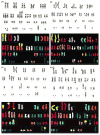Establishment and exploitation of hyperdiploid and non-hyperdiploid human myeloma cell lines
- PMID: 17760811
- PMCID: PMC2748973
- DOI: 10.1111/j.1365-2141.2007.06742.x
Establishment and exploitation of hyperdiploid and non-hyperdiploid human myeloma cell lines
Erratum in
- Br J Haematol. 2008 Feb;140(4):475
Abstract
The establishment of clinically relevant human myeloma cell lines is central for our understanding of myeloma pathogenesis and development of novel therapies for the disease. Unfortunately, most available lines were generated from extramedullary sites, harbored multiple genetic abnormalities and categorized as non-hyperdiploid. In contrast, hyperdiploid myeloma cell lines, which represent more than 50% of patients, are rare. We established procedures for establishment of stroma-dependent myeloma lines by passaging primary myeloma cells, in severe combined immunodeficient-human (SCID-hu) or SCID-rab mice followed by maintenance in co-culture with stromal cells. We described the establishment and characterization of two hyperdiploid (LD and CF) and two non-hyperdiploid (JB and BN) cell lines. Using our animal models, we also established bortezomib-sensitive and -resistant BN lines. These cell lines were cellularly, phenotypically and molecularly characterized using flow cytometry immunophenotyping, DNA content, G-band and multicolor spectral karyotyping (SKY) and global gene expression profiling. All four cell lines were infected with lentiviral-expressing luciferase for detection of tumour cells at high sensitivity level and for monitoring myeloma growth in co-cultures and in vivo by live animal imaging. These myeloma cell lines and the procedures used for their establishment provide essential tools for studying myeloma biology and therapy.
Figures





Comment in
-
Cell lines of hyperdiploid myeloma, are we there yet?Br J Haematol. 2008 Mar;140(5):579-80; author reply 580-1. doi: 10.1111/j.1365-2141.2007.06905.x. Epub 2007 Nov 19. Br J Haematol. 2008. PMID: 18028478 Free PMC article. No abstract available.
Similar articles
-
Intratibial injection of human multiple myeloma cells in NOD/SCID IL-2Rγ(null) mice mimics human myeloma and serves as a valuable tool for the development of anticancer strategies.PLoS One. 2013 Nov 6;8(11):e79939. doi: 10.1371/journal.pone.0079939. eCollection 2013. PLoS One. 2013. PMID: 24223204 Free PMC article.
-
VOLIN and KJON-Two novel hyperdiploid myeloma cell lines.Genes Chromosomes Cancer. 2016 Nov;55(11):890-901. doi: 10.1002/gcc.22388. Epub 2016 Jul 12. Genes Chromosomes Cancer. 2016. PMID: 27311012
-
Reduced CXCR4 expression is associated with extramedullary disease in a mouse model of myeloma and predicts poor survival in multiple myeloma patients treated with bortezomib.Leukemia. 2013 Oct;27(10):2075-7. doi: 10.1038/leu.2013.148. Epub 2013 May 14. Leukemia. 2013. PMID: 23728080 Free PMC article. No abstract available.
-
Molecular pathogenesis of multiple myeloma: basic and clinical updates.Int J Hematol. 2013 Mar;97(3):313-23. doi: 10.1007/s12185-013-1291-2. Epub 2013 Feb 28. Int J Hematol. 2013. PMID: 23456262 Free PMC article. Review.
-
Proteasome inhibition and multiple myeloma.Curr Opin Investig Drugs. 2007 Jun;8(6):447-51. Curr Opin Investig Drugs. 2007. PMID: 17621873 Review.
Cited by
-
Therapeutic effects of intrabone and systemic mesenchymal stem cell cytotherapy on myeloma bone disease and tumor growth.J Bone Miner Res. 2012 Aug;27(8):1635-48. doi: 10.1002/jbmr.1620. J Bone Miner Res. 2012. PMID: 22460389 Free PMC article.
-
The proteasome inhibitor, bortezomib suppresses primary myeloma and stimulates bone formation in myelomatous and nonmyelomatous bones in vivo.Am J Hematol. 2009 Jan;84(1):6-14. doi: 10.1002/ajh.21310. Am J Hematol. 2009. PMID: 18980173 Free PMC article.
-
Fenretinide inhibits myeloma cell growth, osteoclastogenesis and osteoclast viability.Cancer Lett. 2009 Nov 1;284(2):175-81. doi: 10.1016/j.canlet.2009.04.022. Epub 2009 May 15. Cancer Lett. 2009. PMID: 19446953 Free PMC article.
-
A peptide nucleic acid targeting nuclear RAD51 sensitizes multiple myeloma cells to melphalan treatment.Cancer Biol Ther. 2015;16(6):976-86. doi: 10.1080/15384047.2015.1040951. Epub 2015 May 21. Cancer Biol Ther. 2015. PMID: 25996477 Free PMC article.
-
CRAC and SK Channels: Their Molecular Mechanisms Associated with Cancer Cell Development.Cancers (Basel). 2022 Dec 23;15(1):101. doi: 10.3390/cancers15010101. Cancers (Basel). 2022. PMID: 36612099 Free PMC article. Review.
References
-
- Abbaszadegan MR, Foley NE, Gleason-Guzman MC, Dalton WS. Resistance to the chemosensitizer verapamil in a multi-drug-resistant (MDR) human multiple myeloma cell line. International Journal of Cancer. 1996;66:506–514. - PubMed
-
- Akiyama M, Hideshima T, Hayashi T, Tai YT, Mitsiades CS, MItsiades N, Chauhan D, Richardson P, Munshi NC, Anderson KC. Cytokines modulate telomerase activity in a human multiple myeloma cell line. Cancer Research. 2002;62:3876–3882. - PubMed
-
- Bataille R, Klein B, Jourdan M, Rossi JF, Durie BG. Spontaneous secretion of tumor necrosis factor-beta by human myeloma cell lines. Cancer. 1989;63:877–880. - PubMed
-
- Bergsagel PL, Kuehl WM. Chromosome translocations in multiple myeloma. Oncogene. 2001;20:5611–5622. - PubMed
-
- Bergsagel PL, Kuehl WM. Molecular pathogenesis and a consequent classification of multiple myeloma. Journal of Clinical Oncology. 2005;23:6333–6338. - PubMed
Publication types
MeSH terms
Substances
Grants and funding
LinkOut - more resources
Full Text Sources
Other Literature Sources
Medical
Research Materials

